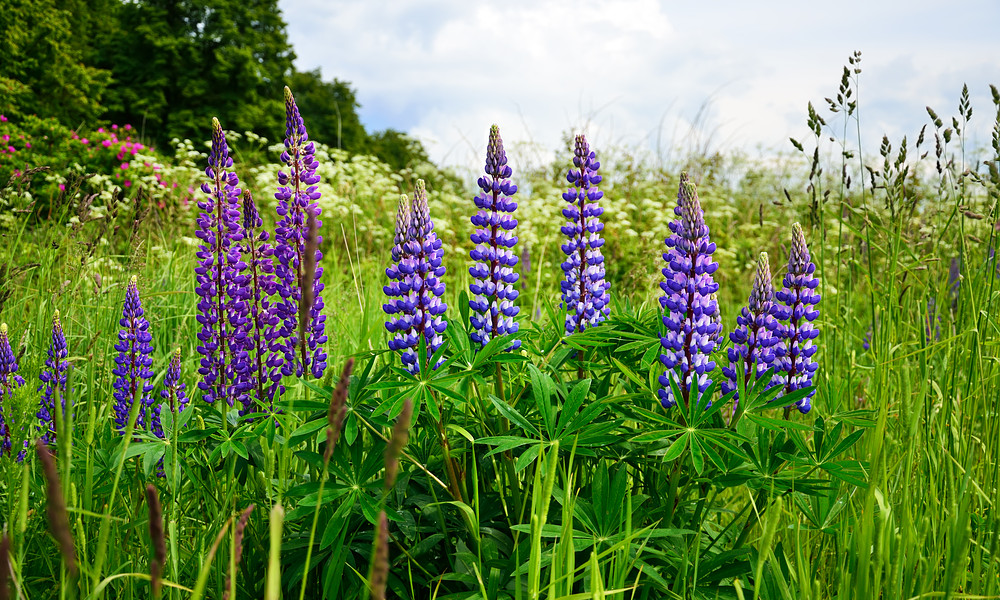Lupin: the super bean that can do almost anything
- Research stories

Plant-based raw materials form the basis of the biobased economy. There is one super crop that can be used for almost all these applications: the lupin.
Plant-based materials are not only essential for our diet (such as vegetable proteins in meat substitutes) but also offer sustainable alternatives to other industries. Think of bioplastics, textiles, dyes, medicines and ingredients for cosmetics. There is one super crop that can be used for almost all these applications: the lupin. In the Horizon 2020 project LIBBIO (Lupinus mutabilis for Increased Biomass from marginal lands and value for BIOrefineries), professor Rob van Haren investigated the Andean Lupin, a variant of this superbean. The Andean Lupin is a leguminous crop with a purple-blue color rich in protein and dietary fibre. In addition, this plant can grow well on fallow land and can even improve the soil quality. The crop is ideal for a future with a growing world population, in which we will have to grow more and more food. As the name suggests, the Andean Lupin comes from the Andean area. This project investigated the possibilities for European cultivation. Could we adapt the plant to grow successfully in our climate? Researchers from each knowledge institution in this international project focused on maximising the yield of this plant. Rob van Haren's research group focused on the extraction of valuable substances from the lupin plant. The extraction of valuable substances from plants is also called 'biorefinery'.
But more on this later - we will start at the beginning.

Lector Transitie Circulaire Bioeconomie
You can't just bring a plant from the Andean region to Europe. First, the Andean Lupin had to be made suitable for cultivation in Europe. Wageningen University, one of the partners in the project, worked together with a seed distribution company. In the project, the researchers succeeded in maximising the cultivation and yield of the plant.
The Andean Lupin can be grown in summer in Northern and Central Europe and in winter in the Mediterranean areas. A big advantage is that the lupin can use marginal soils. The plant produces its own fertilisers by fixing nitrogen from the air. As a result, the lupin bypasses the increasing demand for fertile soil in Europe.

This video describes how the growth and cultivation of the lupine has been studied.
The biorefinery of the Andean Lupin offers many possibilities. Van Haren: 'Lupin is very suitable for many applications, including as a substitute for animal proteins and as a raw material for many biobased products. Moreover, the lupin also grows well on poor soil. Wouldn't it be wonderful to see blue fields from here to far into Poland in twenty years time?' For this you first have to remove the important substances from the lupin. From the Hanze University of Applied Sciences, Rob van Haren's group therefore focused on the biorefinery of the Andean Lupin. A sustainable extraction method was used for this: supercritical CO2 extraction.
The application possibilities in new food and non-food products were then tested. For example, proteins, oils and probiotics can be extracted from the lupin bean for processing in food and cosmetics. The possibilities seem endless: "The oil released during the biorefinery of the lupin bean can be used for margarine and mayonnaise, for example. Probiotics are bacteria that provide healthy gastrointestinal flora. And the proteins can be used for milk or yogurt, but can also be used in meat substitutes. On top of that, the oil also has very interesting cosmetic properties, suitable for lipstick or hair products." (Rob van Haren in Science Guide)

This video describes how the lupine is processed into various products.
The Andean Lupine has a bright future in Europe. Thanks to the LIBBIO project, a variety of the Andean Lupin has been developed that is suitable for cultivation in Europe: the Cotopaxi. The breed is included in the European breed list. As soon as the crop is grown on a larger scale, enriched protein can be produced regionally and locally in short chains.
The Andean Lupin can play a major role in the protein transition in the future. At the moment, we import a lot of soy from South America, where rainforests are cut down to build soy fields. Much of this imported soy is used as animal feed. It's a shame when you realise that there are plant-based protein sources that we can grow locally, which are suitable for both food (people) and feed (animals): "We must be able to produce and process plant-based proteins locally and regionally with healthy revenue models. The Northern Netherlands must switch to larger-scale cultivation of healthy and nutrient-rich crops and learn how to efficiently process them in short chains into attractive, well-priced products that consumers like to buy. Field beans and lupins are very suitable. These are crops that are now mainly used as animal feed and that is pure waste from a sustainable point of view." The future is clear to Rob van Haren: "We must learn to produce plant-based protein enriched in short chains regionally and locally and process it optimally into tasty products with high nutritional value." (Rob van Haren in NoordZ)

This video explains how to extract value from the lupine
The lupin bean offers even more possibilities. In an earlier project called [...] professor Rob van Haren investigated the valuable substance in lupine shells: lupeol. This botanical substance can be used in the pharmaceutical and cosmetic industry. Lupin shells are a residual stream of the processing of lupin beans. About 25% of the bean is peeled, so you can imagine how many peels remain after the bean has been processed. This project investigated how we can extract lupeol in a sustainable and efficient way. In this way we get value from waste.
Is there actually anything this super bean cannot do? Rob van Haren continues to investigate the lupin, so who knows, maybe one day we will find out.
How satisfied are you with the information on this page?
Give your opinion
Thanks for your feedback. We will do something with it.
Hanze University of Applied Sciences uses cookies to ensure that the website functions optimally, some of which are placed for third-party services. Want to know more? Read our cookie policy at cookie policy.
Hanze University of Applied Sciences uses cookies to ensure that the website functions optimally, some of which are placed for third-party services. Want to know more? Read our cookie policy at cookie policy.
Only cookies that are necessary for the basic operation of the website are loaded. Only anonymous basic information is used for website analysis. No personal data is stored.
To be able to use additional functions, such as videos and forms, functional cookies are placed. Only anonymous basic information is used for website analysis. No personal data is stored.
Statistical cookies are used to improve the user experience, which means there are more possibilities for website analysis. Only anonymous information is used for website analysis. No personal data is stored.
Marketing cookies are used to show relevant advertisements on advertising platforms such as Facebook and Google. The cookies share individual data about your surfing behavior on our website.
This element requires cookies.
Accept 'functional cookies' to see this content.